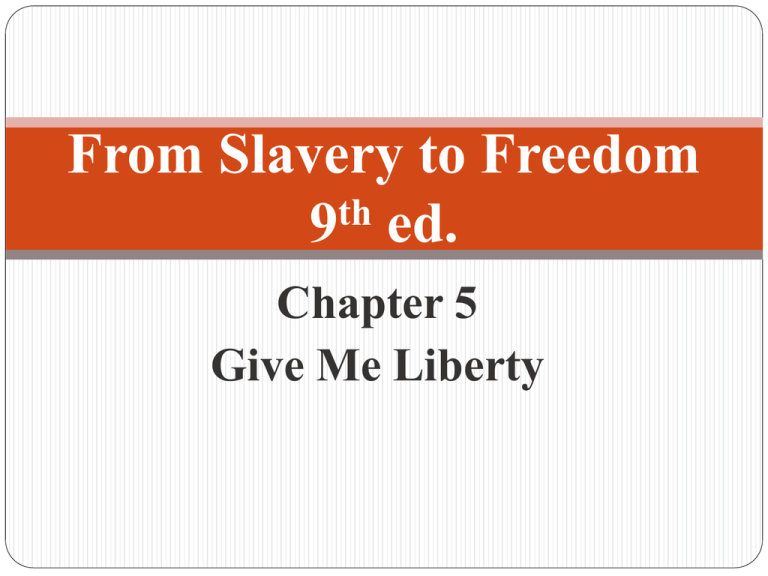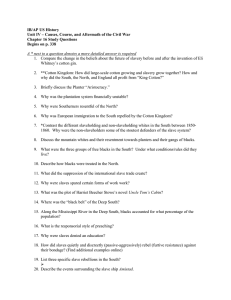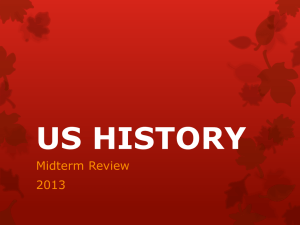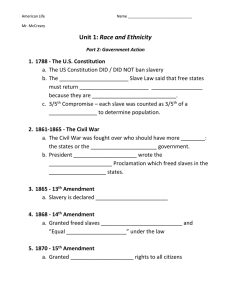
From Slavery to Freedom
th
9 ed.
Chapter 5
Give Me Liberty
American foot soldiers during the
Yorktown campaign, 1781
2
© 2010 The McGraw-Hill Companies, Inc. All Rights Reserved.
The Paradox of Slavery and
Freedom
Freedom in a Slave Society
Colonial propaganda
“No taxation without representation”
Use of racial imagery
Revolutionary rhetoric of freedom rallied whites
while tightening grip on blacks
The “American paradox” – calls for freedom for whites
while keeping blacks as property
Jefferson’s sympathetic words against slavery
stricken from Declaration of Independence
Unacceptable to delegations from the Lower South
3
© 2010 The McGraw-Hill Companies, Inc. All Rights Reserved.
The Paradox of Slavery and
Freedom
Some colonists began to admit the contradiction
in the identity of oppressed colonist and
slaveholder
Birth of the Antislavery Movement
White antislavery rhetoric not lost on slaves
Boston slaves at forefront of black freedom petition
movement
Northern blacks participated in street protests
4
© 2010 The McGraw-Hill Companies, Inc. All Rights Reserved.
The Paradox of Slavery and
Freedom
Crispus Attucks
Runaway slave killed in the Boston Massacre
Buried with honors
Phillis Wheatley
Famous slave poet; intellect nurtured by master
While a slave, traveled to England to oversee
publication of her book, meet her patron
Set free upon return
5
© 2010 The McGraw-Hill Companies, Inc. All Rights Reserved.
The Boston Massacre
6
© 2010 The McGraw-Hill Companies, Inc. All Rights Reserved.
Fighting for American
Independence
Blacks Against the British
Colonists struggled with question of arming both
slave and free blacks
Blacks fought at Lexington, Concord, Battle of
Bunker Hill
One month after formation of Continental Army,
official policy was to reject services of black soldiers
The British Appeal
Dunmore Proclamation – give slaves freedom if
join British army
7
© 2010 The McGraw-Hill Companies, Inc. All Rights Reserved.
Barzillai Lew
8
© 2010 The McGraw-Hill Companies, Inc. All Rights Reserved.
Fighting for American
Independence
Black unrest intensified
Dunmore’s “Ethiopian Regiment”
Virginia Convention denounced British acts, promised
to pardon slaves who returned within 10 days
Washington’s Response
Worried about enlistment of blacks in British
army
Partially reversed earlier policy – allowed free
blacks who previously served to join the ranks
9
© 2010 The McGraw-Hill Companies, Inc. All Rights Reserved.
Fighting for American
Independence
The Revolution and Slavery
Revolutionary struggle had unsettling effect on
slavery
Also became struggle between master and slave
General Clinton’s Proclamation
Slaves in service of Patriots to be sold if
captured; slaves who sought refuge with British
protected
Fugitive slaves often became plunder of war for
both sides
10
© 2010 The McGraw-Hill Companies, Inc. All Rights Reserved.
Fighting for American
Independence
Individual State Policies
Rebel’s military policies began to liberalize
States began to vie against each other in enlisting blacks
Only Georgia and South Carolina opposed enlistment of black
soldiers
Black Military Distinction
5,000 of 20,000 Revolutionary soldiers black
Only few separate fighting units; most integrated
Many distinguished black soldiers
Future Haitian revolutionaries assisted French
11
© 2010 The McGraw-Hill Companies, Inc. All Rights Reserved.
Fighting for American
Independence
Black Loyalists
American victory caused dispersal of black
Loyalists
Many sent to Caribbean; reinvigorated plantations
Freed blacks went to Nova Scotia and England
Some left England and settled in Sierra Leone
12
© 2010 The McGraw-Hill Companies, Inc. All Rights Reserved.
Loyalist black migration to Canada
and Sierra Leone
13
© 2010 The McGraw-Hill Companies, Inc. All Rights Reserved.
The Movement to Free the Slaves
Antislavery Advocates
Pennsylvania Abolition Society first antislavery
society
Most Patriot soldier slaves were freed upon
enlistment or promised freedom at end of service
High profile people began to speak out against
slavery
Antislavery societies more widespread after
the war
Collected information on slavery, published reports on
progress of emancipation
14
© 2010 The McGraw-Hill Companies, Inc. All Rights Reserved.
The Movement to Free the Slaves
Free North, Slave South
Upper South, slaves freed only by private
manumission
In the North, states began to adopt laws
abolishing slavery
15
© 2010 The McGraw-Hill Companies, Inc. All Rights Reserved.
The Conservative Reaction
Shays’s Rebellion
Farmers’ revolt for economic justice
Blacks participated on both sides
The Three-Fifths Compromise
Slavery central on issues of taxation and
representation at Constitutional Convention
Many whites did not want to be on equal footing as
blacks
Delegates agreed to count black men as three-fifths of
all other people
16
© 2010 The McGraw-Hill Companies, Inc. All Rights Reserved.
The Conservative Reaction
The Slave Trade
By the time of the Constitutional Convention,
many states already prohibited Atlantic slave
trade
South Carolina’s Charles Pinckney refused to
accept a Constitution that prohibited the Atlantic
slave trade
Compromise allowed Lower South to continue
Atlantic slave trade for at least 20 years
17
© 2010 The McGraw-Hill Companies, Inc. All Rights Reserved.
The Conservative Reaction
Fugitive Slaves
Almost no opposition to provision that states be
required to surrender fugitive slaves to their
owners
The Language of the Constitution
The words slavery and slave do not appear in
Constitution
Instead, “all other persons” or “such persons”
18
© 2010 The McGraw-Hill Companies, Inc. All Rights Reserved.




